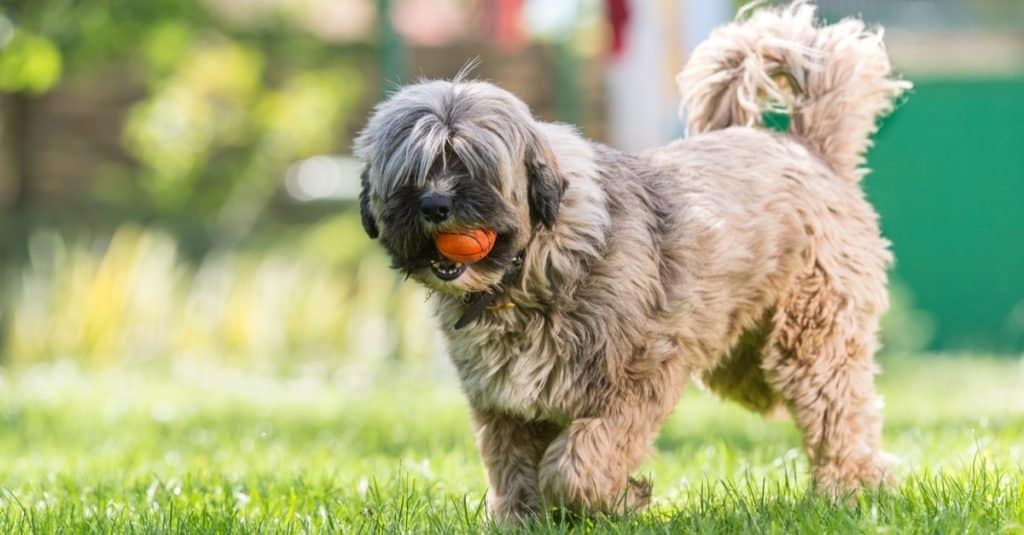The Tibetan Terrier and Lhasa Apso are breeds of dogs that originated in Tibet. They both have a historical association with Buddhist monasteries. They first arrived in the United Kingdom in the 1920s. At first, the Kennel Club classified both the Tibetan Terrier and the Lhasa Apso as Lhasa Terriers. The two breeds were later named separately in the 1930s.
The first Tibetan Terriers were imported into the United States in 1956 and were recognized by the American Kennel Club in 1973, classifying them as part of the non-sporting group. Lhasa Apsos transferred to the same group in 1959, though they were placed in the Utility Group in the UK.
Apart from the same origin, there are other good reasons why people thought the Tibetan Terrier and the Lhasa Apso were all the same. They both have a protective double coat. The undercoat is typically woolly and rather soft to keep them warm.
We have come up with an overview of the key differences between the Tibetan Terrier and the Lhasa Apso to show you their varying physical attributes, temperament, and exercise, among others. Read on for more information.
Comparing Tibetan Terrier vs Lhasa Apso

| Key Differences | Tibetan Terrier | Lhasa Apso |
|---|---|---|
| Size | Height: 14 to 17 inches (35 to 43 cm) Weight: 18 to 30 pounds (8 to 14 kg) | Height: 10 to 11 inches (25 to 28 cm) Weight: 12 to 18 pounds (5.4 to 8.2 kg) |
| Color | Black, gray, white, brindle, gold | Black, brown, white, golden, blonde, sandy |
| Physical features | -Longer shaped head, long legs -V-shaped ears-Strong, medium-length muzzle | -Less pronounced muzzle |
| Temperament | -Energetic, playful, and stubborn -Mischievous | Confident, friendly, comical |
| Exercise | Very active dogs who make excellent jogging partners | Need a moderate amount of exercise every day |
| Age of maturity | 16 to 18 months from birth to full maturity | Take nearly three years to fully mature |
6 Key Differences Between the Tibetan Terrier and Lhasa Apso
Although they may look similar at first glance, the most obvious difference between Tibetan Terriers and Lhasa Apsos is their size. Other differences include appearance, temperament, exercise, and age of maturity.
Tibetan Terriers are larger than Lhasa Apsos, therefore classified as medium-sized dogs, while Lhasa Apsos are more obviously small. Besides, Tibetan Terriers have well-muscled bodies with longer-shaped heads, while Lhasa Apsos have smaller heads with less pronounced muzzles. This is very apparent when you compare the two breeds side by side.
Here are the 6 key differences between the Tibetan Terrier and Lhasa Apso in more detail.
Tibetan Terrier vs Lhasa Apso: Size

An adult Tibetan Terrier stands between 14 and 17 inches tall.
©Fotokostic/Shutterstock.com
Tibetan Terriers are often mistaken for larger versions of Lhasa Apsos. An adult Tibetan Terrier stands between 14 and 17 inches (35 and 43 cm) tall and weighs approximately 18 to 30 pounds (8 to 14 kg). Fully grown Tibetan Terriers closely resemble a miniaturized Bearded Collie.
Lhasa Apsos are very small dogs with thin frames. They grow up to 10 and 11 inches (25 to 28 cm) tall and weigh about 12 to 18 pounds (5.4 to 8.2 kg). Males are a bit large, but the difference is fairly minimal.
Tibetan Terrier vs Lhasa Apso: Color

Lhasa Apsos come in different color variations.
©Lianne McKnight/Shutterstock.com
Tibetan Terriers come in many colors, including black, gray, white, brindle, and gold, although gold is the rarest. Some Tibetan Terriers are available in any combination of red, tri-color, parti-color (white and red sable), or solid. Regardless of the color, the Tibetan Terrier comes in, the eyes and eyes rim remains dark, and the nose leather is black.
Like Tibetan Terriers, Lhasa Apsos also come in different color variations. The most prominent colors include black (solid black), brown, white, golden (pale golden to wheaten), and blonde, among others. However, the Lhasa Apso has almond-shaped dark brown eyes, and the ears appear pendant.
Tibetan Terrier vs Lhasa Apso: Physical Features

Lhasa Apsos have small, deep-set eyes and pendant ears that are heavily feathered.
©Ricantimages/Shutterstock.com
Tibetan Terriers have a longer-shaped head with a strong muzzle and a skull that is neither flat nor rounded. Their eyes are moderately large and appear to be set fairly far apart. The Tibetan Terrier’s body is compact and well-muscled, standing several inches larger than an average Lhasa. The tail is feathered, set high, and carried in a curl over the back. Tibetan Terriers have one of the most distinct broad, flat feet with hairs between the toes, perfectly acting as natural snowshoes, especially when climbing mountains.
On the contrary, Lhasa Apsos have small, deep-set eyes and pendant ears that are heavily feathered. Their heads are slightly smaller with a less pronounced muzzle.
Tibetan Terrier vs Lhasa Apso: Temperament
Tibetan Terriers pack many desirable traits into their personality. They are independent-minded, mischievous, stubborn, and playful. They are very sweet dogs who appreciate relationships based on mutual respect and cooperation. Repetitive training bores them, and they don’t like being scolded. Their instinct is to bark whenever someone approaches the door since they evolved as alert dogs for Buddhist monks in monasteries.
The Lhasa Apso is a confident, friendly, and affectionate breed with a strong instinct to protect and watch over the home since it evolved as a guard dog. Lhasa Apsos are also stubborn and impatient, requiring consistent training to keep them well-behaved. They usually suffer from separation anxiety, especially once they bond with some family members.
Tibetan Terrier vs Lhasa Apso: Exercise

As dogs that require regular exercise, Tibetan Terriers are well-suited for dog sports.
©Sue Thatcher/Shutterstock.com
Tibetan Terriers are very active dogs that require regular exercise, which is why they are well-suited for dog sports. They usually turn to random acts of destruction to amuse themselves if you don’t allow them to burn off all the extra energy. Unlike Tibetan Terriers, Lhasa Apsos have a moderate energy level, so they don’t require much exercise.
Tibetan Terrier vs Lhasa Apso: Age of Maturity
Unlike Lhasa Apsos, Tibetan Terriers attain sexual maturity earlier. Tibetan Terrier puppies are ready to leave their parents or their breeders at about 10 to 12 weeks of age and become fully mature at about 16 to 18 months. Lhasa Apso puppies take about three years to reach adulthood.
The photo featured at the top of this post is © iStock.com/f8grapher
Ready to discover the top 10 cutest dog breeds in the entire world?
How about the fastest dogs, the largest dogs and those that are -- quite frankly -- just the kindest dogs on the planet? Each day, AZ Animals sends out lists just like this to our thousands of email subscribers. And the best part? It's FREE. Join today by entering your email below.
Thank you for reading! Have some feedback for us? Contact the AZ Animals editorial team.






